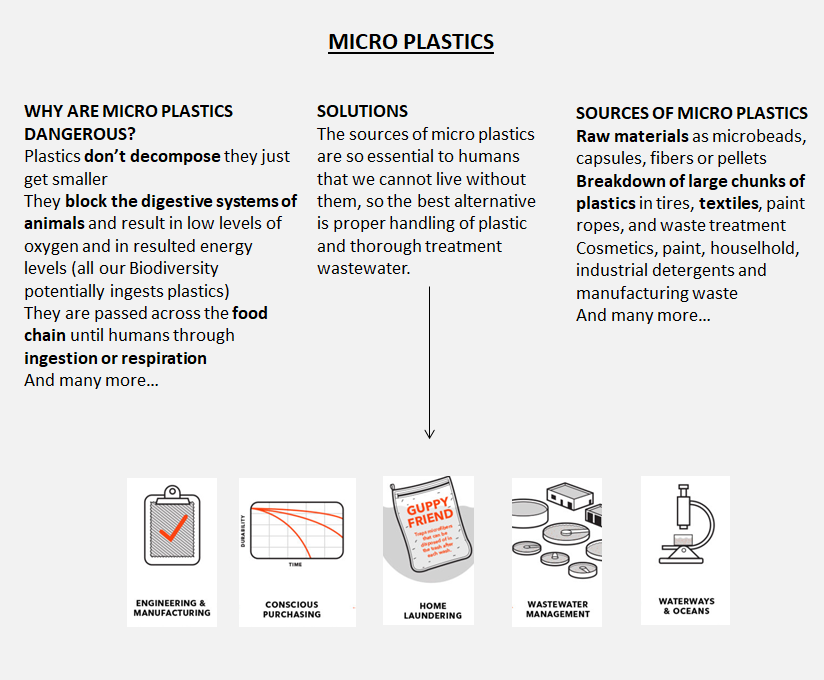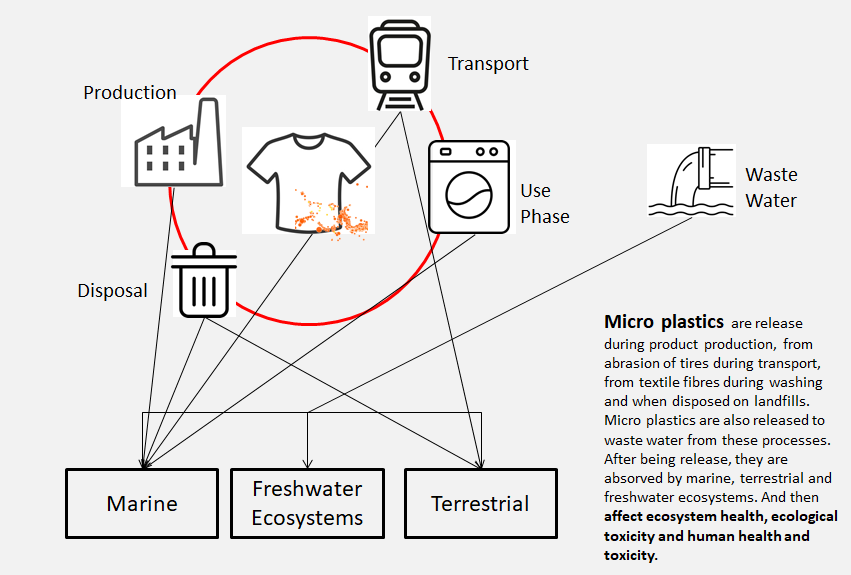Novel Entities X Fashion Industry
By: Inês Leite de Castro
July 2019
Novel Entities as a Planetary Boundary
The planetary boundaries framework defines nine global biophysical boundaries that keep humanity safe operating space in regards to the planet Earth’s resources and limits that reflect biophysical systems and process. In this page we will focus on explaining one of the nine boundaries: the release of novel entities, specifically micro plastics in connection with the textile industry.
This boundary was first identify in 2009 as Chemical Pollution, however nowadays is defined by Novel Entities, as seen in the Chart below:

The process of quantifying novel entities is complex and it is a field with many unknowns. To be able to identify entities that are considered a global concern to the environment, they need to exhibit persistence, mobility across scales with consequent widespread distributions and potential impacts on vital Earth-system process or subsystems. There are already 100,000 substances in global commerce identified without even considering nano materials and plastic polymers that degrade to micro plastics. And this makes it really difficult to identify the global scale effects of these entities, as to be able to identify which chemical substances are likely to be globally problematic, we need to be able first identify them. Some novel entities already identified are the emissions of toxic compounds such as synthetic organic pollutants, radioactive materials, genetically modified organisms, nano materials and micro plastics.
But the challenge for scientists and research community goes further than identification. In order to avoid that they become a global problem, there has to be a developed enough knowledge that allows to screen these chemicals before they are release to the environment. There is not yet a global-level analysis of chemical pollution and the release of novel entities on which to base a control variable for all and that is one of the reasons that there isn’t a boundary value.
However, there is a potential thread from these novel entities to disrupt the functioning of our Earth-system, so society needs to learn how to manage these unknown risks and chemicals under uncertainty and before having more answers.
Understanding what are novel entities and what thread they pose to humans is just the beginning of the path to reduce their impact. There are already a lot of chemicals inserted in our environment that come from different businesses and industries considered essential in our modern life that are having already a big impact. One of these industries is Fashion industry, that is considered one of the most polluting industries globally.
Micro Plastics
Micro plastics are tiny plastic particles found in the environment, less than five millimeters in size. For a long time, a majority of people were unaware of the presence of micro plastics or the effects on the environment. However, these particles have gain a lot of attention these days as researchers found their presence in bottled water that was previously considered safe for human use. There are different types of micro plastics: primary micro plastics are produced and meant for external use and secondary micro plastics occur as a result of the breakdown of large plastic debris. We can see both primary and secondary micro plastics in the environment in different ecosystems.
But why are micro plastics so dangerous? Where are they coming from? Is there a solution for eliminating micro plastics? Consider this Chart below gives an overview of some answers to this questions:

We don’t know the long term implications of ingesting micro or inhaling plastics, but it would be fair to say that they are likely have a negative effect on human health. However, we don’t know at what extent or how necessarily it will manifest itself in the future.
Fashion Industry and Micro Plastics
It is estimated that 80 billion items of clothing are delivered out of factories annually worldwide. By 2015, 62.9 million tons of synthetic fibers were produced worldwide. Synthetic textiles are one of the main sources of micro plastic pollution and account for 35% of all micro plastics. Overall, fashion is deeply connected to the release of micro plastics in the environment and it is deteriorating different ecosystems. Consider this Chart where you can see the overall impact of this Industry.

Fashion industry impacts the entire ecosystem, as an example, just by washing an item of clothing made of synthetic fiber can release up to 700,000 microscopic fibers in the water. At the moment, there are no solutions for recycling textiles, so every year we are producing more and more textiles that are going to stay and impact our ecosystem for longer years to come. The only exception currently is the recycling of PET bottles into polyester fibers, practice that has become quite common from brands trying to be more sustainable. However, this solution may not be a solution after all. Recycled polyester garments also shed micro fibers, and some studies even say that they shred more fibers that polyester garments. Also, it would be much better for the environment if those plastic bottles were collected and prevented from entering the sea again, specially in developing countries.
There is still a long way to go, and we need to invest in science and research in order to deepen our knowledge. It will not be possible to make all the plastic and micro plastics already in the environment disappear, so we need to find solutions to reduce the impact of the already existing micro plastic, find new materials for the need of new plastic and find a way to reduce the overall consumption of plastic.
Sources:
Beverley H., Kirsi L.and Ingun G., 20 February 2019, Microfibres from apparel and home textiles: Prospects for including microplastics in environmental sustainability assessment, viewed 17 July 2019, from https://www.sciencedirect.com/science/article/pii/S004896971834049X
Greenpeace, n.d., July 2017, Fast Fashion, Fatal Fibres, viewed 16 July 2019, from https://www.greenpeace.de/sites/www.greenpeace.de/files/i03971e_gp_flyer_mikrofaser_7_17.pdf
Jones D., 15 April 2019, Airborne Microplastics – Should we be Surprised, or Worried?, viewed 16 July 2019, from https://justoneocean.org/airborne-microplastics-surprised-worried
Kiprop V., 27 March 2018, What Are Microplastics And Why Are They Bad?, viewed 16 July 2019, from https://www.worldatlas.com/articles/what-are-microplastics-and-why-are-they-bad.html
Linn M., Magnus B., Ian T., Cynthia A., Matthew M., and McLachlan M., 2013, Environmental Science & Technology, viewed 17 July 2019
STOP! Micro Waste n.d., Microplastic, viewed 15 July 2019 from https://stopmicrowaste.com/en/microplastic
University of Cambridge, n.d., 2019, Linking planetary
boundaries to business, viewed 17 July 2019, from https://www.cisl.cam.ac.uk/resources/publication-pdfs/linking-planetary-boundaries.pdf
Welcome to the Anthropoene n.d., Planetary Boundaries, viewed 15 July 2019 from http://www.anthropocene.info/pb2.php